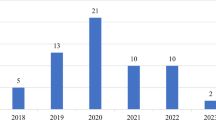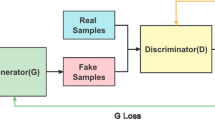Abstract
Generative adversarial network (GAN) is a powerful method to reproduce the distribution of a given data set. It is widely used for generating photo-realistic images or data collections that appear real. Evolutionary GAN (E-GAN) is one of state-of-the-art GAN variations. E-GAN combines population based search and evolutionary operators from evolutionary algorithms with GAN to enhance diversity and search performance. In this study we aim to improve E-GAN by adding transfer learning and crossover which is a key evolutionary operator that is commonly used in evolutionary algorithms, but not in E-GAN.
Access this chapter
Tax calculation will be finalised at checkout
Purchases are for personal use only
Similar content being viewed by others
References
Arjovsky, M., Bottou, L.: Towards principled methods for training generative adversarial networks. arXiv preprint arXiv:1701.04862 (2017)
Arora, S., Zhang, Y.: Do GANs actually learn the distribution? An empirical study. arXiv: abs/1706.08224 (2017)
Arotaritei, D.: Genetic algorithm for fuzzy neural networks using locally crossover. Int. J. Comput. Commun. Control 6(1), 8–20 (2011)
Foo, Y.W., Goh, C., Lim, H.C., Zhan, Z.H., Li, Y.: Evolutionary neural network based energy consumption forecast for cloud computing. In: 2015 International Conference on Cloud Computing Research and Innovation (ICCCRI), pp. 53–64. IEEE (2015)
García-Pedrajas, N., Ortiz-Boyer, D., Hervás-Martínez, C.: An alternative approach for neural network evolution with a genetic algorithm: crossover by combinatorial optimization. Neural Netw. 19(4), 514–528 (2006)
Goodfellow, I.J., et al.: Generative adversarial networks. arXiv: abs/1406.2661 (2014)
Heusel, M., Ramsauer, H., Unterthiner, T., Nessler, B., Hochreiter, S.: GANs trained by a two time-scale update rule converge to a local Nash equilibrium. arXiv preprint arXiv:1706.08500 (2017)
Kim, K.J., Cho, S.B.: Prediction of colon cancer using an evolutionary neural network. Neurocomputing 61, 361–379 (2004)
Krizhevsky, A., Hinton, G., et al.: Learning multiple layers of features from tiny images (2009)
Liu, Z., Luo, P., Wang, X., Tang, X.: Deep learning face attributes in the wild. In: Proceedings of the IEEE International Conference on Computer Vision, pp. 3730–3738 (2015)
Mo, S., Cho, M., Shin, J.: Freeze the discriminator: a simple baseline for fine-tuning GANs. arxiv 2020. arXiv preprint arXiv:2002.10964 (2020)
Salimans, T., Goodfellow, I., Zaremba, W., Cheung, V., Radford, A., Chen, X.: Improved techniques for training GANs. arXiv preprint arXiv:1606.03498 (2016)
Spears, W.M., Anand, V.: A study of crossover operators in genetic programming. In: Ras, Z.W., Zemankova, M. (eds.) ISMIS 1991. LNCS, vol. 542, pp. 409–418. Springer, Heidelberg (1991). https://doi.org/10.1007/3-540-54563-8_104
Wang, C., Xu, C., Yao, X., Tao, D.: Evolutionary generative adversarial networks. IEEE Trans. Evol. Comput. 23, 921–934 (2019)
Yu, F., Seff, A., Zhang, Y., Song, S., Funkhouser, T., Xiao, J.: LSUN: construction of a large-scale image dataset using deep learning with humans in the loop. arXiv preprint arXiv:1506.03365 (2015)
Author information
Authors and Affiliations
Corresponding authors
Editor information
Editors and Affiliations
Rights and permissions
Copyright information
© 2022 Springer Nature Switzerland AG
About this paper
Cite this paper
Liu, Z., Sabar, N., Song, A. (2022). Improving Evolutionary Generative Adversarial Networks. In: Long, G., Yu, X., Wang, S. (eds) AI 2021: Advances in Artificial Intelligence. AI 2022. Lecture Notes in Computer Science(), vol 13151. Springer, Cham. https://doi.org/10.1007/978-3-030-97546-3_56
Download citation
DOI: https://doi.org/10.1007/978-3-030-97546-3_56
Published:
Publisher Name: Springer, Cham
Print ISBN: 978-3-030-97545-6
Online ISBN: 978-3-030-97546-3
eBook Packages: Computer ScienceComputer Science (R0)




